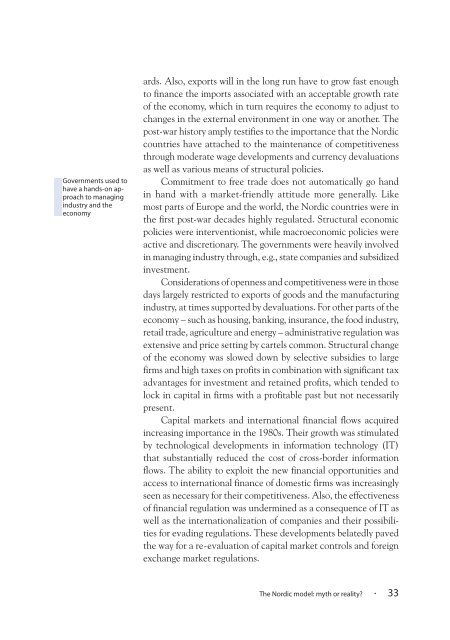The Nordic Model - Embracing globalization and sharing risks
The Nordic Model - Embracing globalization and sharing risks
The Nordic Model - Embracing globalization and sharing risks
Create successful ePaper yourself
Turn your PDF publications into a flip-book with our unique Google optimized e-Paper software.
Governments used to<br />
have a h<strong>and</strong>s-on approach<br />
to managing<br />
industry <strong>and</strong> the<br />
economy<br />
ards. Also, exports will in the long run have to grow fast enough<br />
to finance the imports associated with an acceptable growth rate<br />
of the economy, which in turn requires the economy to adjust to<br />
changes in the external environment in one way or another. <strong>The</strong><br />
post-war history amply testifies to the importance that the <strong>Nordic</strong><br />
countries have attached to the maintenance of competitiveness<br />
through moderate wage developments <strong>and</strong> currency devaluations<br />
as well as various means of structural policies.<br />
Commitment to free trade does not automatically go h<strong>and</strong><br />
in h<strong>and</strong> with a market-friendly attitude more generally. Like<br />
most parts of Europe <strong>and</strong> the world, the <strong>Nordic</strong> countries were in<br />
the first post-war decades highly regulated. Structural economic<br />
policies were interventionist, while macroeconomic policies were<br />
active <strong>and</strong> discretionary. <strong>The</strong> governments were heavily involved<br />
in managing industry through, e.g., state companies <strong>and</strong> subsidized<br />
investment.<br />
Considerations of openness <strong>and</strong> competitiveness were in those<br />
days largely restricted to exports of goods <strong>and</strong> the manufacturing<br />
industry, at times supported by devaluations. For other parts of the<br />
economy – such as housing, banking, insurance, the food industry,<br />
retail trade, agriculture <strong>and</strong> energy – administrative regulation was<br />
extensive <strong>and</strong> price setting by cartels common. Structural change<br />
of the economy was slowed down by selective subsidies to large<br />
firms <strong>and</strong> high taxes on profits in combination with significant tax<br />
advantages for investment <strong>and</strong> retained profits, which tended to<br />
lock in capital in firms with a profitable past but not necessarily<br />
present.<br />
Capital markets <strong>and</strong> international financial flows acquired<br />
increasing importance in the 1980s. <strong>The</strong>ir growth was stimulated<br />
by technological developments in information technology (IT)<br />
that substantially reduced the cost of cross-border information<br />
flows. <strong>The</strong> ability to exploit the new financial opportunities <strong>and</strong><br />
access to international finance of domestic firms was increasingly<br />
seen as necessary for their competitiveness. Also, the effectiveness<br />
of financial regulation was undermined as a consequence of IT as<br />
well as the internationalization of companies <strong>and</strong> their possibilities<br />
for evading regulations. <strong>The</strong>se developments belatedly paved<br />
the way for a re-evaluation of capital market controls <strong>and</strong> foreign<br />
exchange market regulations.<br />
<strong>The</strong> <strong>Nordic</strong> model: myth or reality? · 33

















